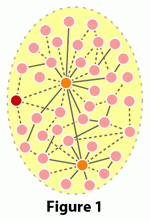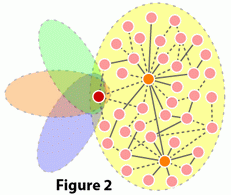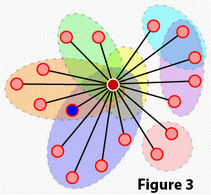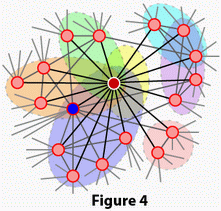A unified look at communities and social networks
From the translator. The author of this publication is Michael Wu ( Michael Wu ), a leading analyst at Lithium , specializing in the study of social interactions and online communities.
Earlier, I talked about the difference between communities and social networks, as well as the special roles they play in building , developing and maintaining relationships between people. In these publications, we analyzed the structure of communities and social networks separately. In reality, however, they coexist and overlap with each other. At any given moment in time, we are part of many communities and at the same time are connected through a social network with both people from these communities and people outside of them.
Today I will try to give a unified look at communities and social networks so that we can understand how these two social structures fit together. This publication is a bit more abstract and theoretical than the previous ones, but I believe that it will give a new perspective and be useful for practical work with social media.

As we found out, most of the strong relationships in our personal social network (or simply in our personal network) were developed within communities that once became part of our life. Figure 1 illustrates the dynamics of a person (let him be called Bob, in the figure he is indicated by a red dot) joining the community (indicated by the yellow oval).
')
Relying on his personal experience, everyone will confirm the fact that when someone joins a community, his personal network does not necessarily join with him. After all, the way it is: our friends, as a rule, do not follow us everywhere, in any case, they do not do this instantly, and certainly not every one of them does so. Why it happens? The main reason is that people have different interests, supported by different communities in which they participate. By joining the community and interacting with other participants, Bob creates weak links (dotted lines in the figure). If interactions were desired by both parties, and for their development a suitable environment existed for a certain time, then some of these weak links that have arisen grow into strong bonds that inevitably become part of Bob’s personal social network.
As you can see, it is quite possible to have a social network within the community. In fact, social networks evolve naturally in communities that provide their users with a rich environment for participation and interaction. Participants who invest a lot of their time and energy in the community, as a rule, have a more extensive network (like orange dots in the figure) than new participants (pink dots in the figure) with a much smaller number of connections. But this is only a part of Bob’s entire social network, it’s his social network tied to a specific community.

In reality, the picture is much more complicated, because Bob, like most other people, does not belong to just one community. Most people at any given time are part of several communities at the same time. Figure 2 illustrates this situation in which Bob actually participates in three other communities (blue, green, and orange). Please note that within each of these communities, in fact, is the same complex social structure, as in the yellow community, we just hid these unnecessary details.
Although the global social network covers the entire earth, our personal network, which includes only our direct contacts, is much smaller. This means that we are able to analyze Bob’s network in more detail. Focusing on his personal network, we will hide all communications that are not directly related to him. As we agreed a little earlier, Bob had just joined the yellow community, before that he did not know anyone here and had not yet managed to build any lasting relationships with anyone. Therefore, if we hide the details and look only at Bob’s personal network, we will see that he has no connections in the yellow community.

However, Bob already participates in three other communities, and we can analyze his connections that he has built in them. Figure 3 shows all of Bob's friends, as well as all of the communities to which they belong (black solid lines indicate direct connections with Bob). We see that Bob has friends in the blue, green and orange communities. Moreover, one of his friends (the blue dot in the picture) shares with him two communities (blue and orange). Please note that Bob also has friends who do not share any communities with him. They belong to the pink, purple and blue community respectively. Where did these friends come from?
When we grow up, or when our lives change, it is natural for us to leave some communities and join others. But as with the help of the social network, we maintain relationships that we have previously built in communities, it is logical to suddenly discover connections with people located outside our current communities. The above picture means that Bob left the pink, purple and blue communities at one time, or his friends left their communities that shared with Bob and subsequently joined the pink, purple and blue communities.
Now that we understand the structure of the communities around Bob, we can begin to fill in the structure of his social network. Figure 3 is incomplete because it does not show how Bob's friends are interconnected. If Bob's friends did not know each other, this picture would be correct. However, this is unrealistic because social dynamics (for example, the rule of a closed triad , or the homophilia property) that governs the formation of connections, as a rule, creates clicks among friends.

This reasoning leads us to Figure 4 , which shows the structure of Bob’s personal social network and also demonstrates how it fits with the structure of the communities around it. The black lines represent Bob’s direct relationship, and the gray lines represent the relationship between his friends. Together they make up Bob’s personal network. We see how the different communities that Bob or his friends belong to are built into the structure of his personal social network. Communities can be found not only within the personal network, but they also exist in the global social network. This will become more apparent to us if we are aware of the fact that the global network includes each of us in this world. Therefore, any community consisting of a subset of the world's population must inevitably be located within the global network.
So what have we learned today? Although the topological structures of communities and social networks vary greatly, and each social structure has a unique function in human history, they are closely intertwined, and in fact complement each other.
Earlier, I talked about the difference between communities and social networks, as well as the special roles they play in building , developing and maintaining relationships between people. In these publications, we analyzed the structure of communities and social networks separately. In reality, however, they coexist and overlap with each other. At any given moment in time, we are part of many communities and at the same time are connected through a social network with both people from these communities and people outside of them.
Today I will try to give a unified look at communities and social networks so that we can understand how these two social structures fit together. This publication is a bit more abstract and theoretical than the previous ones, but I believe that it will give a new perspective and be useful for practical work with social media.
Social networks within communities

As we found out, most of the strong relationships in our personal social network (or simply in our personal network) were developed within communities that once became part of our life. Figure 1 illustrates the dynamics of a person (let him be called Bob, in the figure he is indicated by a red dot) joining the community (indicated by the yellow oval).
')
Relying on his personal experience, everyone will confirm the fact that when someone joins a community, his personal network does not necessarily join with him. After all, the way it is: our friends, as a rule, do not follow us everywhere, in any case, they do not do this instantly, and certainly not every one of them does so. Why it happens? The main reason is that people have different interests, supported by different communities in which they participate. By joining the community and interacting with other participants, Bob creates weak links (dotted lines in the figure). If interactions were desired by both parties, and for their development a suitable environment existed for a certain time, then some of these weak links that have arisen grow into strong bonds that inevitably become part of Bob’s personal social network.
As you can see, it is quite possible to have a social network within the community. In fact, social networks evolve naturally in communities that provide their users with a rich environment for participation and interaction. Participants who invest a lot of their time and energy in the community, as a rule, have a more extensive network (like orange dots in the figure) than new participants (pink dots in the figure) with a much smaller number of connections. But this is only a part of Bob’s entire social network, it’s his social network tied to a specific community.

In reality, the picture is much more complicated, because Bob, like most other people, does not belong to just one community. Most people at any given time are part of several communities at the same time. Figure 2 illustrates this situation in which Bob actually participates in three other communities (blue, green, and orange). Please note that within each of these communities, in fact, is the same complex social structure, as in the yellow community, we just hid these unnecessary details.
Communities within social networks
Although the global social network covers the entire earth, our personal network, which includes only our direct contacts, is much smaller. This means that we are able to analyze Bob’s network in more detail. Focusing on his personal network, we will hide all communications that are not directly related to him. As we agreed a little earlier, Bob had just joined the yellow community, before that he did not know anyone here and had not yet managed to build any lasting relationships with anyone. Therefore, if we hide the details and look only at Bob’s personal network, we will see that he has no connections in the yellow community.

However, Bob already participates in three other communities, and we can analyze his connections that he has built in them. Figure 3 shows all of Bob's friends, as well as all of the communities to which they belong (black solid lines indicate direct connections with Bob). We see that Bob has friends in the blue, green and orange communities. Moreover, one of his friends (the blue dot in the picture) shares with him two communities (blue and orange). Please note that Bob also has friends who do not share any communities with him. They belong to the pink, purple and blue community respectively. Where did these friends come from?
When we grow up, or when our lives change, it is natural for us to leave some communities and join others. But as with the help of the social network, we maintain relationships that we have previously built in communities, it is logical to suddenly discover connections with people located outside our current communities. The above picture means that Bob left the pink, purple and blue communities at one time, or his friends left their communities that shared with Bob and subsequently joined the pink, purple and blue communities.
Now that we understand the structure of the communities around Bob, we can begin to fill in the structure of his social network. Figure 3 is incomplete because it does not show how Bob's friends are interconnected. If Bob's friends did not know each other, this picture would be correct. However, this is unrealistic because social dynamics (for example, the rule of a closed triad , or the homophilia property) that governs the formation of connections, as a rule, creates clicks among friends.

This reasoning leads us to Figure 4 , which shows the structure of Bob’s personal social network and also demonstrates how it fits with the structure of the communities around it. The black lines represent Bob’s direct relationship, and the gray lines represent the relationship between his friends. Together they make up Bob’s personal network. We see how the different communities that Bob or his friends belong to are built into the structure of his personal social network. Communities can be found not only within the personal network, but they also exist in the global social network. This will become more apparent to us if we are aware of the fact that the global network includes each of us in this world. Therefore, any community consisting of a subset of the world's population must inevitably be located within the global network.
Conclusion
So what have we learned today? Although the topological structures of communities and social networks vary greatly, and each social structure has a unique function in human history, they are closely intertwined, and in fact complement each other.
- Social networks naturally develop within communities.
(for example, friends on Yelp) - Communities may exist (and often exist) within social networks.
(e.g. fan pages and Facebook groups)
Source: https://habr.com/ru/post/138632/
All Articles